|
With
all the well known and some less well known problems of lost master tapes and poor
digital mastering it is a relief to find that the result of the 'Elvis
at SUN' project is much better and more
uniform than really ought to be possible to achieve. This is due to
mostly lucky circumstances regarding what actually has been found in
recent years, combined with some recent, unusually well calibrated tape
transfers by Sony and perhaps most important of all, the huge manual
restoration effort carried out by Kevan Budd. For those who care, even
the relative amplitude in terms of RMS power distribution has been
carefully measured and set by hand for consistency and for a uniform
impression of vocal amplitude regardless of source. This is very much
the opposite direction of normal mastering of vintage music of today,
which seems to be focused on pushing up the level as much as possible
over the 0 dB limit.
Harbor Lights, I Love You Because,
That's All Right and Blue Moon of Kentucky
Being an early take of an abandoned recording, possibly from the
first session on July 5, 1954,
the opening
track Harbor Lights is the weakest performance of
Elvis' SUN recordings. Unexpectedly it also stands out as being one of
the few recordings where the actual SUN master tape has been recovered.
The most audible difference is that the out-of-place 1976 'Legendary
Performer' echo is gone. The new straight transfer actually reveals Sam
Phillips' own, more subtle use of locally miked tape echo. In this case, a
delayed signal from Scotty's guitar is mixed with the live signal
coming from all microphones. This leaves the vocal
almost dry, but with a touch of leakage into Scotty's microphone. The result is a
very full sound overall and a very natural sound of the
vocals.
The above is best illustrated by comparison to the second track,
thought to be from the same session but recorded dry using just one tape machine.
Recording of country ballad I Love You Because was abandoned
after 5 "takes". RCA spliced "takes" 3 and 5 for their LP master in 1956,
but the first complete attempt, "take" 2 is the only consistent full take
without major errors and therefore appropriate to include on a genuine
SUN collection like this. Here we get a very recent Sony transfer of
the original SUN tape. The main characteristics seem to be in the
1-track head of the tape recorder picking up signal from the entire
width of the tape. This also results in a high signal/noise ratio and
may almost be interpreted as truncation of noise, since random noise is
likely to vary along the width of the tape. Apart from that, neutral
amplifiers and careful NAB tape curve calibration seems to characterize
the Sony transfers. The technique is thus optimised for flat transfers
of original album masters or anything else that was mastered for
release in the first place.
I Love You Because
is a dry, flat recording and as much as the Sony transfer
of theoretically is as good as it gets,
some might find it sound a little hard compared to the full sound of Harbor Lights
that actually was transferred by BMG.
Sadly, the SUN master tape of That's All Right is lost forever.
It was used to produce the original single in July 1954 and then once
more in November 1955 when RCA transferred it. Since I Love You
Because and That's All
right were recorded on a rehearsal or session that had failed so
far, there either was no time for Sam to setup or rewind the slapback
tape before recording to produce the characteristic SUN echo. (Only the
latter would support Harbor Lights actually being the first
recording)
The original R&B
side of SUN 209
was dry, just as the outtake that survived on the same session reel as I
Love You Because. To prepare it for re-release RCA added
compression and an entirely different type of echo when SUN Box #2 was
played back for the last time in November 1955. Nevertheless, the RCA
tape copy that still exists, is by far the best remaining source in
terms of signal. The only other option would have been to transfer an
inferior source, a 50-year-old SUN 45 or 78 RPM. Something that
couldn't be justified on a major release aimed at the
general market now that a tape source does exist. Thankfully, That's
All Right is the only alien on 'Elvis at SUN' and as such it is
considered a slight improvement over what has been released before.
The C&W side of SUN 209, Blue Moon of Kentucky is one of the
recordings where no master tape was turned over to RCA in the first
place. A November 1955 RCA tape transfer of a SUN 78 RPM has been used
up until now. Now, Blue Moon of Kentucky is one of the worst recorded/mastered
SUN masters with compression and overdone echo, but it isn't nearly as
bad as the RCA tape implied. RCA compressed it further (to death
actually) in November 1955. A manually cleaned up, new transfer from a
selection of original SUN
78 RPM's has rectified the situation on 'Elvis at SUN' and the improvement
should be obvious.
Blue Moon, Tomorrow Night and
I'll Never Let You Go
Next up is a group of three recordings that perhaps were considered
rejected masters or potential album tracks by Sam Phillips. They ought
to have been recorded at the same session some day between August 19
and early-to-mid September 1954 because they share the same ambience and
warm, original tube sound, all carefully miked for the reverb chain in a way
that can not been identified on other SUN recordings.
As could be heard on the outtake as released on 'Sunrise' back in 1999,
the original SUN Blue Moon tape appears to be very worn. It was
recorded at lower level as well and this does result in a lot of tape
hiss that has been left intact on 'Elvis at SUN' in order to
preserve the signal and ambience. On the other hand, the dropouts have
been repaired. The result is a big improvement over the 'Sunrise'
outtake and of course an even bigger improvement over the previous BMG
master.
The 50's Box digital masters of the nice 1956 RCA tape copies of Tomorrow Night and I'll Never
Let You Go have been replaced by flat Sony transfers on 'Elvis at
SUN'- well
suited here since these masters were finalized by Sam Phillips in the
first place. This new transfer lacked a little high end and this was
only compensated for by as much as the source could handle.
Just Because, Good Rockin' Tonight and
I Don't Care if the Sun Don't Shine
A completely different sound was recorded on the September 1954 session
that produced the second SUN single Good Rockin' Tonight
(R&B side), I
Don't Care if the Sun Don't Shine (C&W side) and the rejected master Just
Because, to be used for the first RCA LP in 1956. The early
generation master tape of I Don't Care if the Sun Don't Shine has
finally been identified as a recovered master this time of course and
the glitch is repaired as good as could be done. A pitch analysis
implies that the recovered tape runs a little too slow on 'Sunrise',
according to Scotty Moore's highly accurate guitar tuning during the
SUN days. This observation is in accordance with the pitch of original
SUN single, but yet Elvis' vocals may sound slightly too
fast. On 'Elvis at SUN' the pitch has been set to that of the original
SUN single and the tuning of Scotty's guitar since most threads point
in that direction.
On 'Elvis at SUN' Good Rockin' Tonight is from a new Sony transfer from the recently found
RCA 30 ips tape. Just Because is a Sony transfer as
well, but from the only, badly filtered, 1956 RCA copy that exists,
apart from the album master of LPM 1254.
Regardless of the now existing, best sources of each of these songs, traces of the
same original tape curve
problems are evident on all the three uptempo September 1954 recordings.
They were recorded with way too much signal in the high end, especially
in the 16 kHz region and with too little signal in the lower, so important 100-200 Hz region. Possibly a noise reduction curve on top of
the NAB curve, or simply poor calibration, but it should be pointed out
that this 16 kHz peak
can be identified on some other SUN artists recordings between late 1954
and early 1955.
RCA must have detected this but missed the target a little and filtered more in
the 14-15
KHz region instead on Good Rockin' Tonight, which is close actually and not
a problem today. On Just Because, RCA filtered out just about
everything in the 9-10 kHz region, where there were no problems at all,
leaving a black hole sacrificing much of the damped acoustic guitar
that was recorded via the reverb tape machine. On 'Elvis at SUN' all three songs have been calibrated with 16 kHz
reduction and just a slight lift of the 100-200 Hz to compensate a
little for what is considered to have been lost in the first place due
to the wrong tape curve calibration. The black
hole on Just Because has been carefully raised, but not
all the way of course, while the 14-15 kHz reduction on Good Rockin'
Tonight was found best left untouched after several blind A-B tests.
Milkcow Blues Boogie, You're a Heartbreaker,
I'm Left You're Right She's Gone (slow) and
I'm Left You're Right She's Gone (master)
The recording sessions that produced the third SUN single Milkcow
Blues Boogie (R&B side) and You're a Heartbreaker
(C&W side) are likely to also have resulted in the final master of I'm
Left You're Right She's Gone (C&W side of fourth single) as
well as the slow, rejected bluesy version of the same song.
The master tapes for Milkcow Blues Boogie and You're a
Heartbreaker were never turned over to RCA, possibly because they
had been recorded over by mistake. RCA made dubs of a Mint 78 RPM copy
that were used to produce replacement masters for a late 1955 single
re-release and for future use by RCA. Both were processed during this
process and many artifacts from the shellac source have remained. All
restoration efforts for later CD releases have been extremely poor and
actually mainly had the opposite effect with introduction of extra
distortion and elimination of ambiance. It is therefore a relief that
it has been possible to replace both masters of the third single with
fresh transfers from a huge selection of other 78 RPM's. If anybody
thought that restoring old sources like this is equivalent to sitting in a
nice air-conditioned office being served grapes and dinners while
pressing buttons of a lot of luxury software to automate the process,
think again. The result from a tedious, manual job on Milkcow Blues Boogie is stunning and
simply has to be heard to be believed.
The pitch is not that easy to solve,
with guitar tuning in contradiction with original 78 RPM pitch and the
60 cycle hum distribution over time (such low frequencies needs
ridiculously high FFT values to even measure with decent accuracy). It is presented at
original speed, which if correct, could be the only SUN recording where
Scotty's guitar wasn't carefully tuned. Going by guitar tuning only,
the pitch would have had to be set slightly slower.
You're a Heartbreaker is a big improvement as well, but not quite
as good as Milkcow Blues Boogie. The reason for this is that few
copies were pressed, as it was the least successful SUN single and that
the You're a Heartbreaker side appears to have been played a lot
more than the R&B side by the few people who bought a copy. If an
Unplayed/Mint copy of this side could be located, You're a
Heartbreaker could have been presented with slightly less surface
noise.
The rejected, slow I'm Left You're Right, My Baby's Gone is of course improved here as well with
dropout repairs and absence of the digital BMG mastering with filtering
and added echo that has haunted us until now. The other outtake that
was released on 'Sunrise' merely suffered from dropouts and poor eq
resulting in a 'hard' sound.
I'm Left You're Right, She's Gone, the C&W side of the
fourth single that wasn't released until 5 months after being recorded
has never sounded anywhere near this good before. The main source was a
Sony transfer of the recently found 30 ips RCA master tape that is at
least one generation down, but not subjected to any bad processing at
all. Since the song on the best tape isn't complete (last song on
compilation tape), it was necessary to combine more than one source to
produce the best result throughout. The now restored and beautifully
matched original uncut ending is a thrill to hear - a personal favorite
on 'Elvis at SUN' considering the final, uniform result from combined sources.
Baby Let's Play House
The February 1955 session that produced the R&B side of the fourth
SUN single, Baby Let's Play House comes from the same Sony
transfer of the recently recovered RCA 30 ips master compilation tape
and there certainly were a few problems with this recording in the
first place. The overall high-end had been reduced in three steps
soon after the
start of the song. This is something that can be traced back to the
original SUN single, but is not as evident behind Bill Putnam's high
end dynamic processing of the original single. It was possible to compensate a little, but
perhaps not all the way within the strict, but necessary rules set out
for 'Elvis at SUN'.
I Forgot to Remember to Forget, Mystery Train and Trying
to Get to You
There exists a fantastic original 15 ips SUN tape copy for the masters of the
fifth and last SUN single I Forgot to Remember to Forget
(C&W side) and Mystery Train (R&B side). This tape was
handed over by Sam in January 1956 and is therefore referred to as the
16th SUN Tape Box. The tape was first used for the 50's Box, but has
now been retransferred flat by Sony with even better results in spite
of the flat, original, unprocessed sound. This is partly due to better
NAB calibration.
The new transfer of I Forgot to Remember has already found its
way to two recent releases. First the 2003 upgrade of 'Great Country
Songs' and later the same year it was used for 'Second to None'. The
introduction of noise-shaping when converting back to 1-bit DSD native
after first converting to 8-bit PCM-narrow in the Sonoma environment to
allow equalization isn't very impressive on either one of them, especially considering the
result was aimed at 16 bit PCM only. However, the slight above 10 kHz
raise done by Sony for these two releases isn't considered out of place at all - it's right on
target actually. It's just the method that seems a little complicated. The distorted clipping of vocal peaks on 'Second to
None' is simply devastating since this source has so much dynamic
range. The 'Great Country Songs' version was clipped as well, but not
nearly as much. The 'Elvis at SUN' version of I Forgot to Remember
is a slight improvement with total absence of clipping being the only
major audible difference compared to 'Great Country Songs'.
The equally great new Sony transfer of the unprocessed, dynamic Mystery
Train makes its debut here on 'Elvis at SUN'. The original,
full-ending-to-the last-note version derived from lost Sun Tape Box #1 (that was reported
to us by Sven Adamski in 1999) has been recovered from the best available
source (tape copy with compression and severe generation loss) and matched
with precision during the fade-out, using all the tricks in the book
and for once stretching all the 'Elvis at SUN' restoration rules. The
result of this impossible task is stunning considering the
circumstances.
According to Sam Phillips Trying to Get to You would have been
the R&B side of Elvis' sixth SUN single. Unfortunately the
surviving RCA copies suffer from more compression than usual and not
even this Sony transfer of the recovered RCA 30 ips tape can do
anything about that. It is a shame how the compression takes over
during the loud vocal parts, but apart from that the new source and
version isn't all that bad, at least not compared to what has been
released before.
When It Rains, It Really Pours
We've had it for years without being able to tell! Exceptionally poor compression
has hidden the fact that When It Rains,
It Really Pours actually is from the dry reverb tape source. On this
recording only Elvis' vocals and acoustic guitar were miked and sent to
the mounted tape machine to produce the typical SUN echo on the other
tape. The electric guitar didn't have to take this path in late 1955
and the echo of Scotty's
Echosonic, purchased on May 24, 1955 (www.scottymoore.net), can be
heard leaking into the dry reverb channel, as can Johnny Bernero's drums
and Bill Black's bass. They certainly were miked through and
recorded directly on the primary console machine, mixed with the
delayed signal of what we have here. It is a revelation to hear it
as it is. Since it is the last recording its inclusion does not
distract the overall impression at all. The unfinished dry reverb tape
recording of When It Rains, It Really Pours can be considered a
bonus track more than anything else.
If Sam Phillips were alive he might have called this a chronological
collection of 11 Masters, 5 rejected master takes or potential album
fillers, 2 abandoned recordings and 1 unfinished recording. To the rest of us this
is an important piece of 20th Century history.
|
TRACKS
01. Harbor Lights (Abandoned)
02. I Love You Because (Abandoned/take 2)
03. That's All Right (Master)
04. Blue Moon of Kentucky (Master)
05. Blue Moon (Rejected Master)
06. Tomorrow Night (Rejected Master)
07. I'll Never Let You Go (Rejected Master)
08. Just Because (Rejected Master)
09. Good Rockin' Tonight (Master)
10. I Don't Care if the Sun Don't Shine (Master)
11. Milkcow Blues Boogie (Master)
12. You're a Heartbreaker (Master)
13. I'm Left You're Right She's Gone (Slow/Rejected Master)
14. I'm Left You're Right She's Gone (Master)
15. Baby Let's Play House (Master)
16. I Forgot to Remember to Forget (Master)
17. Mystery Train (Master)
18. Trying to Get to You (Master)
19. When It Rains It Really Pours (Unfinished)
A-B SAMPLES
2x30 seconds, 256 kbps MP3 (LAME), 1.8 MB each.
Harbor Lights
A-B SAMPLE (1)
A. Previous BMG Master (50's Box)
B. ELVIS AT SUN
When it was first
released in 1976 Harbor Lights suffered from unnecessary
generation loss, bad processing and
rather poor 1970's style echo, different on each stereo channel. Then in the early
1990's more poor mastering and spatial echo was added to the 1976 LP
master and that remaster has been used ever since 1992.
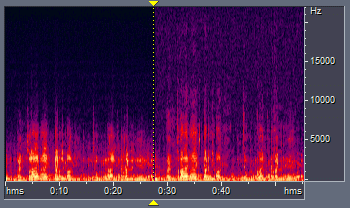
Harbor Lights spectral
plot,
A=Sunrise, B=Elvis at SUN
Loss of signal since 1976 and a horizontal pattern in the filtered high
frequency range that appears to be
the signature of the evil NoNoise algorithm since 1992.
Harbor Lights
A-B SAMPLE (2)
A. Today Tomorrow and Forever (alt. take, 2002)
B. Elvis at SUN
When the
original session tape, that had been lost for some years, finally was
recovered a few years ago this resulted in another take being released
on the 2002 BMG 'Today Tomorrow and Forever' set. The transfer of the
old mono tape was done by BMG on what appears to be a playback of a
1-track mono tape on 2-track stereo machine. That technique would
result in playback of unique, narrow parts of the tape in the Left and
Right channels respectively, resulting in more dropouts and tape noise
than would be the result of Sony's more exact 1-track mono transfers.
I
Love You Because
A-B SAMPLE
A. Sunrise (BMG, 1999)
B. Elvis at SUN
The absence of the
usual mastering is actually what makes I Love You Because take 2 stand
out as better sounding than ever before, although this was one of few
recordings that has been released in decent sound on Sunrise (1999).
That's
All Right
A-B SAMPLE (1)
A. Upgraded BMG master, Second to None (2003)
B. Elvis at SUN
The recently found
RCA tape is recorded at 30 ips, which may not be very rock'n'roll in terms
of bass response when properly calibrated during playback. However, if
that is to be compensated for, the entire balance between frequencies
must be carefully figured out and calibrated as well as opposed to the
rather misplaced bass lift on 'Second to None'. So identical Sony
transfer, but with the absence of poor mastering levels, not fully
figured out eq work
done in the Sonoma environment and resulting bit-depth-reduction
noise-shaping, should make the more faithfully presented, flat ELVIS AT SUN
more appealing to some.
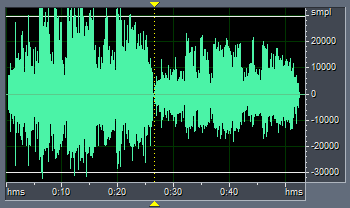
That's All Right waveform,
A=Second to None, B=Elvis at SUN
The philosophy behind Second to None is obvious: "If less than 10%
of the samples are clipped no human being can tell"...
The price of the relative amplitude approach of Elvis a SUN is that the
loudest, compressed songs will have to be mastered at about -3dB.
That's
All Right
SAMPLE (2)
1973 'SUN' 45 RPM copy
of 78 RPM SUN 209
The original, dry
sound. Tape is lost, but for historical reasons, there is all the reason in the world to get
back to this source in a different context in the future.
Blue
Moon of Kentucky
A-B SAMPLE
A. Previous BMG Master, Great Country Songs (2003)
B. Elvis at SUN
RCA's 78 RPM
transfer from 1955 has finally been replaced. One of the worst recorded
SUN masters, but the new source has much better dynamic range.
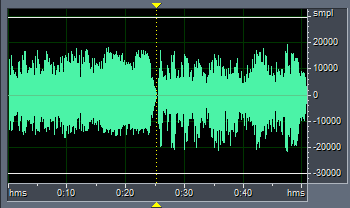
Blue Moon of Kentucky waveform,
A=Great Country Songs, B=Elvis at SUN
The new transfer reveals the extra RCA compression done in 1955.
Blue
Moon
A-B SAMPLE 1
A. Previous BMG Master, 50's Box
B. Elvis at SUN
Blue
Moon
A-B SAMPLE 2
A. Outtake from the same tape (Sunrise)
B. Elvis at SUN
It is restoration that makes the difference here.
Tomorrow
Night
A-B SAMPLE
A. Previous BMG Master, 50's Box
B. Elvis at SUN
I'll
Never Let You Go
A-B SAMPLE
A. Previous BMG Master, 50's Box
B. Elvis at SUN
Just
Because
A-B SAMPLE
A. Previous BMG Master, 50's Box
B. Elvis at SUN
A difficult restoration job to reverse RCA's processing. The intro has
always been cut and is thought to have been so on the SUN tape. Same
thing happened to the intro of Charlie Rich's Rebound and the
ending of Johnny Cash's Wreck of the Old '97.
Good
Rockin' Tonight
A-B SAMPLE
A. Previous BMG Master, 50's Box
B. Elvis at SUN
I
Don't Care if the Sun Don't Shine
A-B SAMPLE
A. Previous BMG "Alternate" (Sunrise)
B. Elvis at SUN
Listen for the "living stereo" fluctuations and 16 kHz
ringing of the unfinished 'Sunrise' mastering.
Milkcow
Blues Boogie
A-B SAMPLE
A. Previous BMG Master, 50's Box
B. Elvis at SUN
You're
a Heartbreaker
A-B SAMPLE
A. Previous BMG Master, 50's Box
B. Elvis at SUN
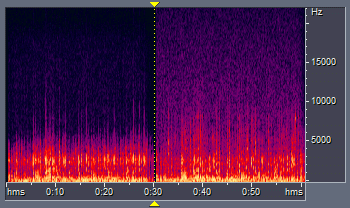
You're a Heartbreaker spectral
plot,
A=Sunrise, B=Elvis at SUN
The response of the recent 78 RPM transfer (B) may not look fantastic
and there is a lot of noise that had to stay. Still, this should be compared to everything that has been released before.
I'm
Left, You're Right, She's Gone (slow)
A-B SAMPLE
A. Previous BMG Master, Sunrise
B. Elvis at SUN
I'm
Left, You're Right, She's Gone
A-B SAMPLE
A. Previous BMG Master, Sunrise
B. Elvis at SUN
Baby
Let's Play House
A-B SAMPLE
A. Previous BMG Master, 50's Box
B. Elvis at SUN
I
Forgot to Remember to Forget
A-B SAMPLE
A. Upgraded BMG Master, Great Country Songs (2003)
B. Elvis at SUN
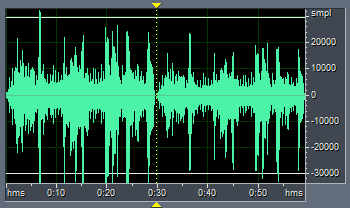
I Forgot to Remember to Forget waveform,
A=Great Country Songs (2003), B=Elvis at SUN
The philosophy behind Great Country Songs seems to be: "If less
than 5% of the samples are clipped no human being can tell"...

I Forgot to Remember to Forget zoomed waveform,
Great Country Songs (2003)
A closer look at a clipped vocal peak as mastered by Sony on 'Great
Country Songs'.
Mystery
Train
A-B SAMPLE
A. Previous BMG Master, Sunrise
B. Elvis at SUN
Trying
to Get to You
A-B SAMPLE
A. Previous BMG Master, 50's Box
B. Elvis at SUN
When
It Rains It Really Pours
A-B SAMPLE
A. Previous BMG Master, Sunrise
B. Elvis at SUN
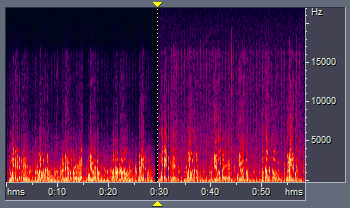
When It Rains It Really Pours
spectral plot,
A=Sunrise, B=Elvis at SUN
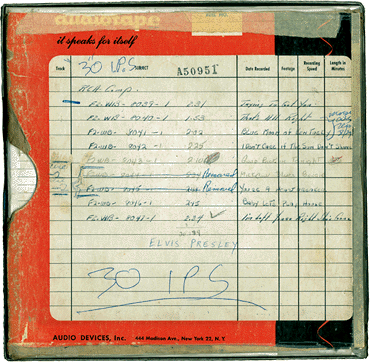
Recently
recovered RCA 30 ips tape
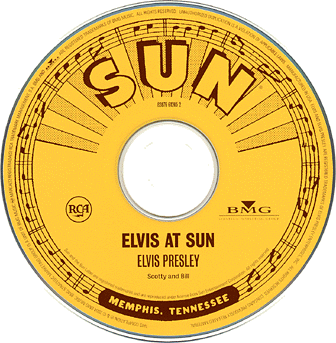
Scotty and Bill credit on RCA...
ADVERTISEMENT

|